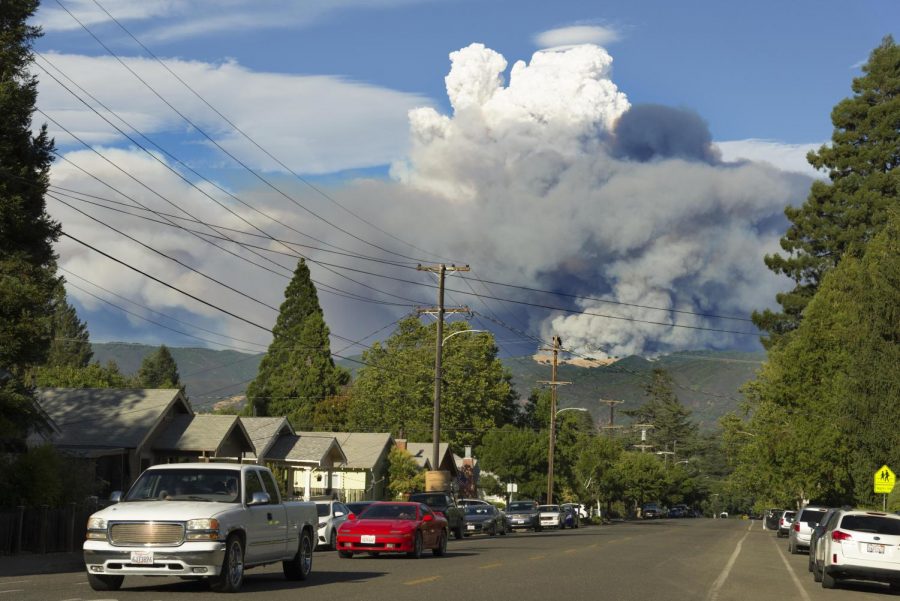Wildfires devastate Mendocino County
Wikimedia Commons
Billows of smoke rise from a forested mountainside over the city of Ukiah in Mendocino County. The Mendocino Complex Fire, which spanned across four northern California counties, was the largest recorded complex fire in California’s history.
October 17, 2018
The largest wildfire in California’s history, the Mendocino Complex Fire, began last July and has officially been 100 percent contained as of Sept. 18, nearly two months after its inception.
The complex, a likely byproduct of an increasingly warmer climate, is the deadly combination of two wildfires, the River Fire and the Ranch Fire, which spanned across the Northern California counties of Mendocino, Lake, Colusa and Glenn.
Surpassing the Thomas Fire, which burned 281,893 acres of land in December 2017, the Ranch Fire is also California’s single largest recorded wildfire. According to Cal Fire, the California Department of Forestry and Fire Protection, it burned 410,203 acres and 157 residences before being contained. The National Interagency Fire Center, which coordinates fire relief efforts, reported the two fires collectively resulting in $267 million in damages and costing $201 million to put out and contain.
The River Fire was contained on Aug. 13, while the Ranch Fire continued to burn for more than a month after. Two Native American reserves, the Hopland and Big Valley Rancherias, were evacuated along with almost a dozen towns residing along the border of the Mendocino and Lake Counties.
Organizations like the Camarillo city based Ventura County Community Center (VCCC) provide much-needed grants and funds to nonprofit groups that help ameliorate the effects of a wildfire disaster by supplying shelter and economic assistance among many other services.
Vanessa Bechtel, VCCC’s CEO, believes that not enough attention is paid to helping victims in the long run, since the rebuilding process could take many years.
“I love being able to help during a time like this,” Bechtel said. “I don’t know what else could be more rewarding than this type of work.”
Hot and windy weather, which helps spread and foster the wildfires, has been a persistent problem faced by firefighters throughout the year, and the situation will not be improving any time soon. The latest California Climate Change Assessment, from Aug. 27, estimates an average temperature increase of 5.6 to 8.8 degrees in the state. Indicative of more frequent droughts and more damaging wildfires, these projections offer a grim outlook on the future.
“Climates are changing at a global scale because we are adding more carbon dioxide into the atmosphere, which elevates global average temperatures,” AP Environmental Science teacher Jeff Sutton said. “Then you have climates such as in the North Pacific Coast Forest where there is less moisture and less water vapor. As a result, it is more susceptible to fire.”
Students and faculty can work against the progression of climate change in many ways.
“Avoiding any kind of emission, which causes phenomena such as global warming and droughts to occur, would be a simple yet long-term aid in preventing some future wildfires,” Anvi Banga (11), president of the upper school Green Team, said.
Christopher Borick, Director of the Muhlenberg College Institute of Public Opinion and Director of the National Surveys on Energy and the Environment, conducts national polls regarding climate change twice a year from Allentown, Pennsylvania. He found that those directly harmed by climate change are more inclined to believe in its existence.
“Extreme drought, intense storms, flooding and wildfires are experiences that have been particularly noted as factors that not only convince people that [climate change] is happening but also increase their confidence that it is happening.”
This piece was originally published in the pages of Winged Post on Oct. 17, 2018.


















![“[Building nerf blasters] became this outlet of creativity for me that hasn't been matched by anything else. The process [of] making a build complete to your desire is such a painstakingly difficult process, but I've had to learn from [the skills needed from] soldering to proper painting. There's so many different options for everything, if you think about it, it exists. The best part is [that] if it doesn't exist, you can build it yourself," Ishaan Parate said.](https://harkeraquila.com/wp-content/uploads/2022/08/DSC_8149-900x604.jpg)




![“When I came into high school, I was ready to be a follower. But DECA was a game changer for me. It helped me overcome my fear of public speaking, and it's played such a major role in who I've become today. To be able to successfully lead a chapter of 150 students, an officer team and be one of the upperclassmen I once really admired is something I'm [really] proud of,” Anvitha Tummala ('21) said.](https://harkeraquila.com/wp-content/uploads/2021/07/Screen-Shot-2021-07-25-at-9.50.05-AM-900x594.png)







![“I think getting up in the morning and having a sense of purpose [is exciting]. I think without a certain amount of drive, life is kind of obsolete and mundane, and I think having that every single day is what makes each day unique and kind of makes life exciting,” Neymika Jain (12) said.](https://harkeraquila.com/wp-content/uploads/2017/06/Screen-Shot-2017-06-03-at-4.54.16-PM.png)








![“My slogan is ‘slow feet, don’t eat, and I’m hungry.’ You need to run fast to get where you are–you aren't going to get those championships if you aren't fast,” Angel Cervantes (12) said. “I want to do well in school on my tests and in track and win championships for my team. I live by that, [and] I can do that anywhere: in the classroom or on the field.”](https://harkeraquila.com/wp-content/uploads/2018/06/DSC5146-900x601.jpg)
![“[Volleyball has] taught me how to fall correctly, and another thing it taught is that you don’t have to be the best at something to be good at it. If you just hit the ball in a smart way, then it still scores points and you’re good at it. You could be a background player and still make a much bigger impact on the team than you would think,” Anya Gert (’20) said.](https://harkeraquila.com/wp-content/uploads/2020/06/AnnaGert_JinTuan_HoHPhotoEdited-600x900.jpeg)

![“I'm not nearly there yet, but [my confidence has] definitely been getting better since I was pretty shy and timid coming into Harker my freshman year. I know that there's a lot of people that are really confident in what they do, and I really admire them. Everyone's so driven and that has really pushed me to kind of try to find my own place in high school and be more confident,” Alyssa Huang (’20) said.](https://harkeraquila.com/wp-content/uploads/2020/06/AlyssaHuang_EmilyChen_HoHPhoto-900x749.jpeg)








